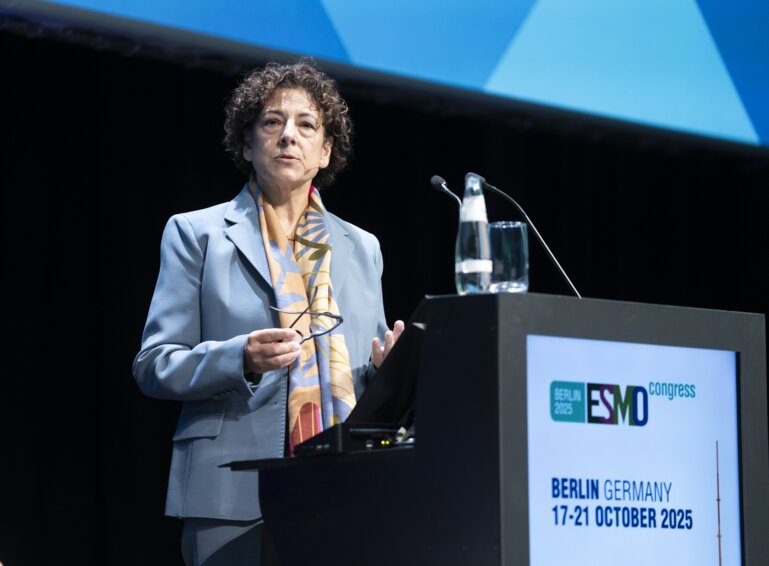Exciting new data show that adjuvant targeted agent olaparib after chemotherapy can cut the risk of BRCA-mutated breast cancer returning or spreading in women
Research has its ups and downs, but contrary to common belief it can sometimes proceed at great speed. PARP inhibition in breast cancer is one example of an innovative treatment approach that made the leap from proof-of-concept to the clinic in less than a decade.
“Having identified the synthetic lethality context caused by mutations in the BRCA1 and BRCA2 genes as a potential therapeutic target in the lab, we already had agents available that could create just the kind of DNA damage to which cancer cells would be vulnerable,” says Prof. Andrew Tutt, Professor of Breast Oncology and Director of the Breast Cancer Now Toby Robins Research Centre at the Institute of Cancer Research (ICR) and the Research Unit at King’s College London. Tutt, who received the ESMO Breast Cancer Award 2021 in recognition of his outstanding contributions to improving our understanding of breast cancer, recently presented results of the landmark adjuvant trial OlympiA (N Engl J Med. 2021 June 3) that suggest the PARP inhibitor olaparib could be important for treating women with genetic early breast cancer.
What have been the major breakthroughs of research in hereditary breast cancer to date?
PARP inhibitors had been designed to sensitise tumours to chemotherapy or radiotherapy, but olaparib was shown to have anti-tumour activity on its own in BRCA-mutation carriers (N Engl J Med. 2009 July 9;361:123-134). The proof of concept was provided by two phase II trials of olaparib in breast cancer (Lancet 2010 July 24;376(9737):235-244) and ovarian cancer (Lancet 2010 July 24;376(9737):245-251). After struggling to broaden PARP inhibitors’ potential use by combining them with chemotherapy, the research refocused on a single-agent approach in this smaller genetic population with both olaparib (N Engl J Med. 2017 August 10;377:523-533) and talazoparib (N Engl J Med. 2018 August 23;379:753-763), leading to their approval for use in metastatic breast cancer in 2018.
Primary analysis of the OlympiA trial data at a median of two to three years from randomisation showed significantly increased invasive disease-free and distant disease-free survival among women with BRCA-mutated, operable breast cancer who received olaparib as adjuvant therapy versus placebo. What do patients stand to gain from expanding the use of PARP inhibitors beyond the metastatic setting?
PARP inhibitors are an additional therapeutic option which can control metastatic breast cancer for years in some patients, but unfortunately the vast majority do eventually develop progression with resistance sometimes occurring within months. The hope is that by using the medicines earlier in the disease we can prevent relapse, and the 43% reduction in the risk of distant recurrence or death observed in the OlympiA trial could support an approval as adjuvant therapy. Whether we can ultimately cure more BRCA1 and BRCA2 mutation carriers, who are prone to more aggressive forms of breast cancer associated with poorer outcomes, is a question that the trial’s ongoing long-term follow-up will answer.
As a tablet-based targeted therapy, PARP inhibitors have also been shown to be less toxic and more tolerable than chemo, with better preservation of patients’ quality of life in the metastatic setting.
Proving their worth in early-stage disease therefore begs the question of whether they could eventually allow us to de-escalate or even replace chemotherapy for some individuals at lower recurrence risk in this setting. Meanwhile, finding better ways to combine PARP inhibitors with chemotherapy (Lancet Oncol. 2020 October 1;21(10):1269-1282, Ann Oncol. 2021 January 1;32(1):49-57) may help us to improve prognosis for the highest-risk patients.
What do you believe will be the next frontier in personalised medicine for mutation carriers?
Looking even beyond the adjuvant setting: if careful, long-term follow-up shows PARP inhibitors to be safe in early breast cancer, then the big question for future research will be whether the toxicity profile and mechanism of action would support their use as a preventive treatment for individuals with a known genetic predisposition to breast cancer caused by a homologous recombination DNA repair gene fault. It is a little too early to speculate on whether this could be feasible, but the question should be investigated for these women who often develop cancer at a very young age, with far-reaching familial, societal and economic consequences.
In ovarian cancer, olaparib is approved for use in tumours with homologous recombination (HR) deficiency beyond those with BRCA1 or BRCA2 mutations. Could a wider population of breast cancer patients also benefit from this approach?
A number of trials have been conducted for BRCA1/2 mutation carriers with BRCA-associated cancers, but other genes such as PALB2 create an analogous synthetic lethality context. Can we apply previous results with BRCA1 and 2 to these alterations, or should we try to run new, specific trials? Conducting studies on such small genetic subsets is difficult – yet leaving the question unanswered would be a mistake because the rationale for the PARP approach in these patients is equally strong.
We also know that 20 to 30% of triple-negative breast cancer patients have methylation in the BRCA1 gene regulatory routes, which leads to a functional deficiency similar to that caused by the mutations. Working out how to detect and treat these cases is complicated by the fact that methylation is more likely than a mutation to change or disappear as a result of selective pressure over the course of the cancer’s evolution, often when exposed to prior DNA-damaging chemotherapy, rendering drugs like platinum agents and PARP inhibitors less effective. However, measuring it in the initial diagnostic stages and again in the residual cancer or at relapse after first-line therapy could offer an opportunity to personalise treatment for these patients with a high unmet need. Trials in this area would be important in my view.








